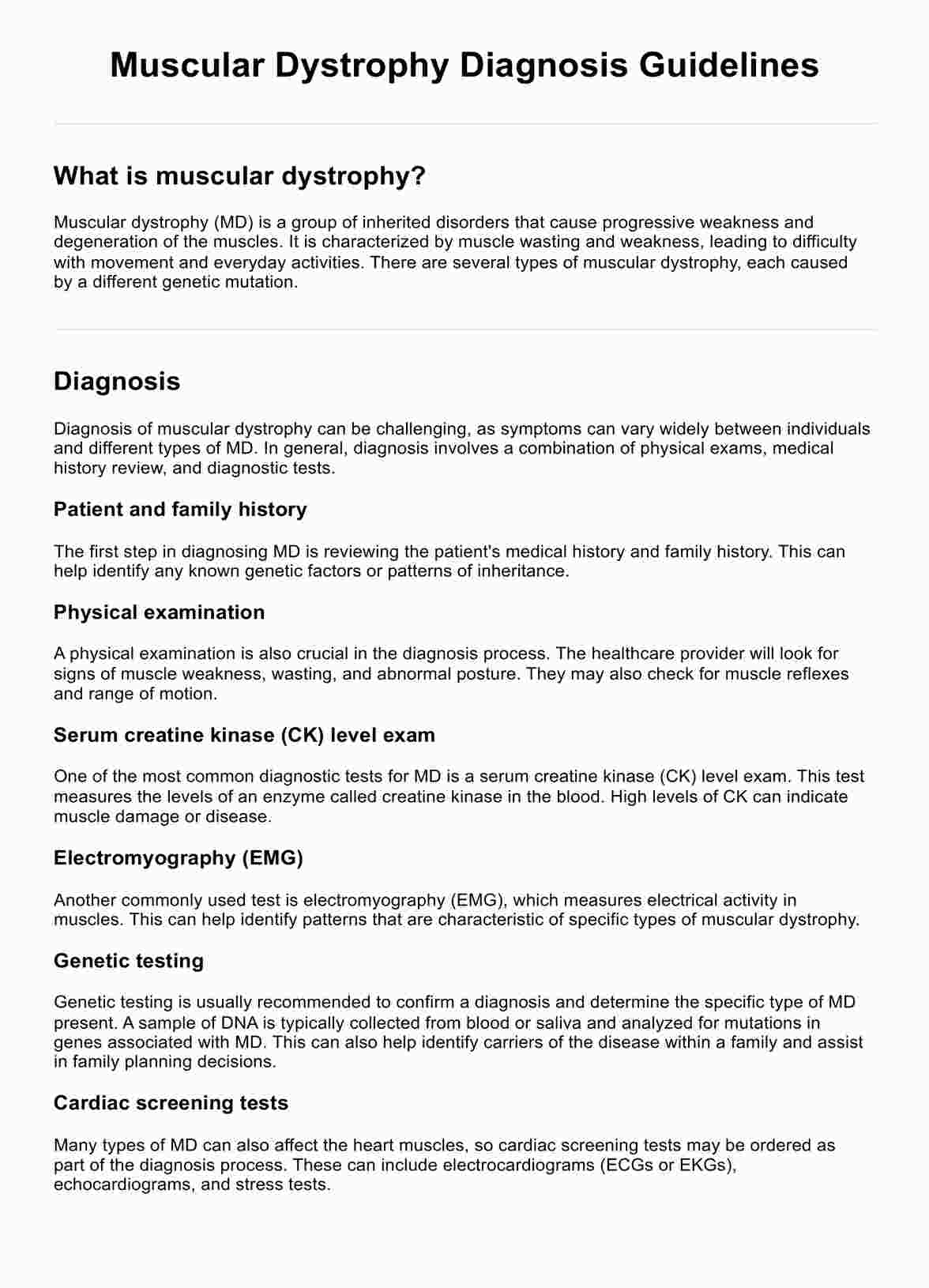Muscular Dystrophy Diagnosis Guidelines
Learn about muscular dystrophy and get access to a free Muscular Dystrophy Diagnosis Guidelines handout. Download now!


What is muscular dystrophy?
Muscular dystrophy refers to a group of more than 30 genetic diseases characterized by progressive muscle weakness and degeneration of skeletal muscles. Different types, including Duchenne muscular dystrophy, Becker muscular dystrophy, limb-girdle muscular dystrophy, distal muscular dystrophy, congenital muscular dystrophy, facioscapulohumeral muscular dystrophy, and oculopharyngeal muscular dystrophy, vary in age of onset, severity, and pattern of muscle involvement.
As muscular dystrophy occurs, muscles progressively weaken, leading to significant physical limitations. Over time, many individuals with muscular dystrophy lose the ability to walk. The disease can also impact other body parts, including the heart, lungs, gastrointestinal system, endocrine glands, spine, eyes, brain, and other organs. Understanding how muscular dystrophy affects muscle tissue is crucial for accurate diagnosis and management.
Common muscular dystrophy symptoms
The main symptom of muscular dystrophy is progressive muscle weakness. Depending on the type, specific signs and symptoms begin at different ages and in different muscle groups. Common symptoms include:
- Frequent falls
- Difficulty rising from sitting or lying position
- Trouble running and jumping
- Waddling gait
- Walking on the toes
- Large calf muscles
- Muscle pain and stiffness
- Learning disabilities
- Delayed growth
Types of muscular dystrophy
There are many types of muscular dystrophy, each affecting specific muscle groups and showing symptoms at different ages. Some of the more common types include:
- Duchenne muscular dystrophy (DMD): Most common childhood form, primarily affects boys
- Becker muscular dystrophy (BMD): Similar to DMD but milder and later onset
- Limb-girdle muscular dystrophies (LGMD): Affects hip and shoulder muscles
- Facioscapulohumeral muscular dystrophy (FSHD): Affects facial, shoulder and upper arm muscles
- Congenital muscular dystrophies: Present at birth or before age 2
- Myotonic dystrophy: Causes inability to relax muscles after contraction
Causes of muscular dystrophy
Mutations in the genes responsible for healthy muscle structure and function cause most cases of muscular dystrophy. The mutations mean muscle cells can no longer work properly, leading to progressive weakness. Many cases are inherited, but some occur spontaneously. Muscular dystrophy can be inherited in an autosomal dominant, autosomal recessive, or X-linked recessive pattern.
Muscular Dystrophy Diagnosis Guidelines Template
Muscular Dystrophy Diagnosis Guidelines Example
How to use our Muscular Dystrophy Diagnosis Guidelines template
Here's how to use our free template to streamline the diagnostic process and ensure thorough, organized patient care.
Step 1: Download the template
Begin by downloading the Muscular Dystrophy Diagnosis Template. This document provides structured guidelines to help streamline the diagnostic process for muscular dystrophy.
Step 2: Refer to the template during clinical evaluation
Use the template as a reference when taking a comprehensive patient and family history and performing physical and neurological examinations. Follow the outlined steps to identify key indicators of muscular dystrophy, such as muscle weakness patterns and developmental motor delays.
Step 3: Utilize laboratory and Imaging Guidelines
Refer to the template for ordering and interpreting laboratory and imaging studies. Follow the recommendations for measuring serum creatine kinase (CK) levels, conducting genetic testing, and performing muscle biopsies. Use these guidelines to ensure thorough and accurate diagnostic evaluations.
Step 4: Diagnose using combined clinical findings
Integrate the information from the template with your clinical findings to make an informed diagnosis. Use the outlined criteria for interpreting diagnostic results, confirming the subtype of muscular dystrophy, and considering differential diagnoses. Refer to the template's guidance for when to involve a neuromuscular specialist and provide genetic counseling.
How healthcare professionals will benefit from this handout
Having a quick reference guide for the key steps in diagnosing muscular dystrophy can help healthcare professionals:
Identify potential red flags
Healthcare professionals can use this handout to identify potential red flags for muscular dystrophy, such as elevated CK levels and consistent muscle biopsy findings.
Make informed diagnostic decisions
By taking into account the patient's clinical presentation, family history, and physical exam findings, healthcare professionals can make more informed diagnostic decisions and confirm a diagnosis if a genetic mutation is identified.
Know when to refer to a specialist
Referring complex or uncertain cases to a neuromuscular specialist can ensure that patients receive accurate diagnoses and appropriate treatment plans.
Educate patients and their families
By providing information on the key steps in diagnosing muscular dystrophy, healthcare professionals can also educate patients and their families about the diagnostic process and what to expect. This can help alleviate any concerns or anxieties they may have and facilitate better communication between the healthcare team and the patient/family.
Commonly asked questions
It depends on the specific type, but symptoms may start anywhere from birth to adulthood. Duchenne muscular dystrophy, the most common childhood form, is usually diagnosed between ages 3 and 6.
Currently there is no cure for any form of muscular dystrophy. Treatment focuses on managing symptoms and optimizing function and quality of life.
Yes, although some types like Duchenne and Becker primarily affect males, females can still be carriers and have mild symptoms. Other types affect both sexes.






































































































